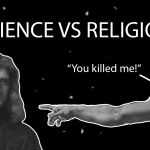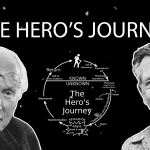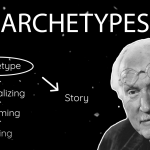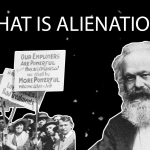Part I: Departure
(Watch the full video on YouTube by clicking here.)
There once was a young prince called Guatama Sakyamuni, the Future Buddha.
For all his life he had been protected by his father from all knowledge of age, sickness, death and monkhood, to prevent the young prince from renunciation of life.
For the father received a prophecy at his birth, that he would either be a world emperor, or a Buddha.
The King of course favoured the world emperor, and thus he provided his son with 3 palaces and forty thousand dancing girls to distract him from the actuality of life.
But after a while all this bliss began to grow stale, so the young prince wished to go to the park.
An elegant chariot was made ready in which he rode off to the park.
“Time for the enlightenment of the young prince nigh,” thought the gods; “We must give him a sign!”
Then one of the man along the chariot was turned into an decrepit old man, broken toothed, grey haired, crooked and bent of a body, leaning on a staff, and trembling, and he was shown to the Future Buddha.
It was done so that only the prince and the charioteer could see the old man, and the prince asked: “Who is this man? Even his hair is not like other man”.
The charioteer answered: “Shame on birth, since to every one that is born old age must come.
Scared and disillusioned the prince returned to the palace.
His farther still tried to protect him from this world, but on a certain day the prince wanted to go to the park again.
This time the future Buddha saw a diseased man as shown by the gods.
Again the prince returned to the palace agitated in heart.
The third time he went to the park he saw a dead man, and again returned to the palace.
The Fourth time the gods showed him a monk, and the prince again asked the charioteer: “Who is this man?”, “Sire, this is one who retired from the world”.
From that moment on, the Future Buddha thought of retiring from this world.
This introduction of the story of Buddha shows the Call to Adventure. It is the start of the heroes journey.
In a perfect world, we would only be moving from where we are, to where we want to go.
Or as Psychologist Jordan Peterson explains in his graph of “normal life”:
We move from what IS, to what SHOULD be, through how we should act.
However, as we know, most often this is not what happens, as there are many internal and external threats to our normal way of life.
In the story of the Buddha, the gods show the young prince how the world actually is, that the bliss is a façade, and that there is suffering and even death. It is the unconcious brought to the conscience.
At some moment in our lives we will realise the same, that life can be suffering, for we know that we ourselves and everybody around us will die eventually.
That there is sickness, despair and old age, just as the Buddha realised.
Or as Jordan Peterson explains:
“The idea that man needs redemption – and that re-establishment of a long-lost Paradise might constitute such redemption – appear as common themes of mythology, among members of exceedingly diverse and long-separated human cultures.24 This commonality appears because man, eternally self-conscious, suffers eternally from his existence, and constantly longs for respite.”
Part II: The Descent
The young prince now left the confines of his fathers palace, passing through the guarded gate, passing through the night attended by the torches of forty times sixty thousand divinities, lightly hurdled a majestic river eleven hundred and twenty eight cubits wide, and then with a singe sword stroke sheared his own royal locks.
Now in the garment of a monk, he moved through the world as a beggar and transcended the 8 stages of meditation.
He retired to a hermit age, bent his powers 6 more years to a great struggle, carried austerity to the uttermost, and finally collapsed in seeming death.
After having had the realisation of the real world, Future Buddha now needs to find who he himself is.
But finding oneself requires for the old version of the person to die. To cast off old believes and the old version of the world.
This is exactly how we feel when our consciousness shows us an unpredicted outcome in our pattern of actions.
When we do not live up to our potential, whatever potential is, or when we unconsciously know we are not doing what we need to be doing, or when we, just as the Future Buddha, accept the journey voluntarily, we are confronted with the unknown.
With Chaos. This archetype of the descent is one that we will repeatedly see, often in the form of being swallowed by a whale, as in the story of Raven, Jonah, and even Pinocchio.
Or the descent into the underworld, where there are snakes, demons and monsters.
But how do we deal with chaos and the unknown?
Part III: Initiation
After recovering from near death, the Future Buddha sat underneath a tree, where a young girl named Sujata presented him with milk-rice in a golden bowl.
When he finished the bowl of milk-rice, he threw it into the river, and the cup floated upstream.
For the Future Buddha, this was a signal that the moment of his triumph was at hand.
He arose and made his way to the tree of Enlightenment, the Bo Tree, under which he was to redeem the universe.
He placed himself with a firm resolve, beneath the Bo Tree, on the Immovable spot the axis mundi, and straight away was approached by Kama-Mare, the god of love and death.
The dangerous god appeared mounted on an elephant and carrying weapons in his thousand hands. He was surrounded by his army, which extended twelve leagues before him, twelve to the right, twelve to the left, and in the rear as far as to the confines of the world; it was nine leagues high.
The protecting deities of the universe took flight, but the Future Buddha remained unmoved beneath the Tree.
And the god then assailed him, seeking to break his concentration.
Whirlwind, rocks, thunder and flame, smoking weapons with keen edges, burning coals, hot ashes, boiling mud, blistering sands and fourfold darkness, the Antagonist hurled against the Saviour, but the missiles were all transformed into celestial flowers and ointments by the power of Gautama’s ten perfections.
More trails were thrown at the Future Buddha, but he was not moved by the attempts.
Having won that preliminary victory before sunset, the conqueror acquired in the first watch of the night knowledge of his previous existences, in the second watch the divine eye of omniscient vision, and in the last watch understanding of the chain of causation. He experienced perfect enlightenment at the break of day.
After our death in the underworld, which represents the death of our ego, we can begin to rebuilt ourselves by means of overcoming multiple trails.
Just as the Buddha defeating the god of love and death,
“In myths the hero is the one who conquers the dragon, not the one who is devoured by it. And yet both have to deal with the same dragon. Also, he is no hero who never met the dragon, or who, if once he saw it, declared afterwards that he saw nothing. Equally, only one who has risked the fight with the dragon and is not overcome by it wins the hoard, the “treasure hard to attain”. He alone has a genuine claim to self-confidence, for he has faced the dark ground of his self and thereby has gained himself. This experience gives some faith and trust, the pistis in the ability of the self to sustain him, for everything that menaced him from inside he has made his own. He has acquired the right to believe that he will be able to overcome all future threats by the same means. He has arrived at an inner certainty which makes him capable of self-reliance.”
It is here a dragon that is mentioned by Jung, for the dragon is the embodiment of our fears and weaknesses.
After all a dragon is part snake, part bird and part cat, the biggest enemies of primordial humans, breathing the most destroying element of all, fire.
Now this dragon can be an outside force, or an inward struggle of the unconcious, eighter way, it needs to be dealt with if we want to prevent our neurosis.
We all know this dragon, for we are not all that we can be. We have not all reached our full potential yet.
And the dark side of our personality that keeps us from being what we need to be is what Jung called: The Shadow.
It is this shadow that we need to confront. or according to Jung:
“This confrontation is the first test of courage on the inner way, a test sufficient to frighten off most people, for the meeting with ourselves belongs to the more unpleasant things that can be avoided so long as we can project everything negative into the environment. But if we are able to see our own shadow and can bear knowing about it, then a small part of the problem has already been solved: we have at least brought up the personal unconscious. The shadow is a living part of the personality and therefore wants to live with it in some form. It cannot be argued out of existence or rationalized into harmlessness. This problem is exceedingly difficult, because it not only challenges the whole man, but reminds him at the same time of his helplessness and ineffectuality.”
After the integration of the shadow, the defeat of the dragon or, in the case of the Buddha, the defeat of Kame-Mare and the letting go of the Ego, we are granted enlightenment.
In the case of the Buddha, this is:
1) the knowledge of his previous existences. That is, the knowledge that we exists only on the corpses of our ancestors, as we will see later in the creation story in the Enuma Elish of the Mesopotamians.
2) The divine eye of omniscient vision, that is the ability to see. An archetype that will repeat again and again, for example in Marduk with eyes around his head, the eye of Horus in Egypt and even the ability to grant sight by Jesus himself.
3) and finally, the understanding of the chain of causality, consciousness. Being able to look into the future.
And that is what we humans are capable of.
And by knowing the future, we can make sacrifices now, that will help us survive later.
Thus consciousness, or enlightenment, lets us look into the past, present and future.
Part IV: The Return
Then for seven days Gautama—now the Buddha, the Enlightened—sat motionless in bliss; for seven days he stood apart and regarded the spot on which he had received enlightenment; for seven days he paced between the place of the sitting and the place of the standing; for seven days he abode in a pavilion furnished by the gods and reviewed the whole doctrine of causality and release; for seven days he sat beneath the tree where the girl Sujata had brought him milk-rice in a golden bowl, and there meditated on the doctrine of the sweetness of Nirvana; finally, the Buddha sat for seven days beneath a fourth tree enjoying still the sweetness of liberation.
Then he doubted whether his message could be communicated, and he thought to retain the wisdom for himself; but the god Brahma descended from the zenith to implore that he should become the teacher of gods and men.
The Buddha was thus persuaded to proclaim the path. And he went back into the cities of men where he moved among the citizens of the world, bestowing the inestimable boon of the knowledge of the Way.
Not everybody is able to return from the underworld, from chaos and the unknown:
“A realization of the inevitable guilt of life may so sicken the heart that, like Hamlet or like Arjuna, one may refuse to go on with it. On the other hand, like most of the rest of us, one may invent a false, finally unjustified, image of oneself as an exceptional phenomenon in the world, not guilty as others are, but justified in one's inevitable sinning because one represents the good. Such self-righteousness leads to a misunderstanding, not only of oneself but of the nature of both man and the cosmos.”
This realisation is what we can today see in people with depression that are no longer able to bear the burden of life with their consciousness.
“The goal of the myth is to dispel the need for such life ignorance by effecting a reconciliation of the individual consciousness with the universal will. And this is effected through a realization of the true relationship of the passing phenomena of time to the imperishable life that lives and dies in all.”
When we thus return from chaos, we completed the heroes journey.
We return to the world to be at a better and higher position than where we came from.
“Such revolutionary modification means update of modelled reality, past, present and future, through incorporation of information generated during exploratory behaviour. Successful exploration transforms the unknown into the expected, desired and predictable; establishes appropriate behavioural measures (and expectations of those measures) for next contact.”
It is important to notice here, that Peterson mentioned Next Contacts.
For we can shield ourselves from chaos, but we can never prevent it from reaching us again and again.
But by the completion of the Heroes Journey, we are capable of defending ourselves. We will only get stronger and stronger.
It is only upon the completion of this full cycle we achieve what Carl Jung called: Individuation
Just as Buddha, we have let go of the ego and the persona, we have integrated the shadow and are one with our self.
We no longer wear the mask of personality, the persona, that only shows us as our profession or that which other people force us to be, or in other words as we have seen in Marx, we are no longer alienated.
“Every advance in culture is, psychologically, an extension of consciousness, a coming to consciousness that can take place only through discrimination. Therefore an advance always begins with individuation, that is to say with the individual, conscious of his isolation, cutting a new path through hitherto untrodden territory. To do this he must first return to the fundamental facts of his own being, irrespective of all authority and tradition, and allow himself to become conscious of his distinctiveness. If he succeeds in giving collective validity to his widened consciousness, he creates a tension of opposites that provides the stimulation which culture needs for its further progress.”
Thus according to Jung, we can only reach our potential, if we voluntarily confront the unknown, integrate our shadow and complete the process of Individuation.
We become our true Self.
Or as expressed in the Bhagavad Gita:
"Even as a person casts off worn-out clothes and puts on others that are new, so the embodied Self casts off worn-out bodies and enters into others that are new. Weapons cut It not; fire burns It not; water wets It not; the wind does not wither It. This Self cannot be cut nor burnt nor wetted nor withered. Eternal, all-pervading, unchanging, immovable, the Self is the same for ever." – Bhagavat Gita, 2:22-24 -
Thank you for watching the video!
I hope that something good happens to you today, or this week, or this month
And to see you in the next video.





